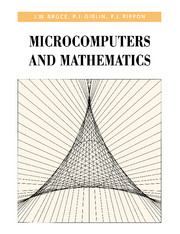Preface
Published online by Cambridge University Press: 05 June 2012
Summary
This book is intended for anyone who has some mathematical knowledge and a little experience with programming a microcomputer in BASIC (or any other language). The book shows how simple programs can be used to do significant mathematics.
To spell out our mathematical prerequisites in more detail, some of the chapters assume no more mathematical knowledge than whole numbers, but for the most part we assume some calculus, and the rudiments of algebra (polynomials, equations) and trigonometry (sines, cosines and tangents). Thus, British readers with A or A/S level in mathematics and American readers with a Freshman calculus course behind them will, we hope, have little difficulty in following most of the mathematics here. We have, naturally, included some material for the more mathematically sophisticated reader: those sections requiring closer inspection are, appropriately, printed in smaller type. (We hope that readers who do not immediately recognise the small type material will be intrigued rather than frightened. Surely one of the charms of mathematics is the glimpses it affords of mysterious and fascinating territory which is for the moment just out of reach.)
As for programming, the knowledge we assume is very small, and most programs are given full listings in the text. It seems to us that a very effective way to learn programming is to use it to solve interesting mathematical problems. We have regarded the mathematics as the pre-eminent interest, and have not tried too hard to make the sample programs beautiful or elegant, or even particularly efficient.
- Type
- Chapter
- Information
- Microcomputers and Mathematics , pp. xi - xivPublisher: Cambridge University PressPrint publication year: 1990

